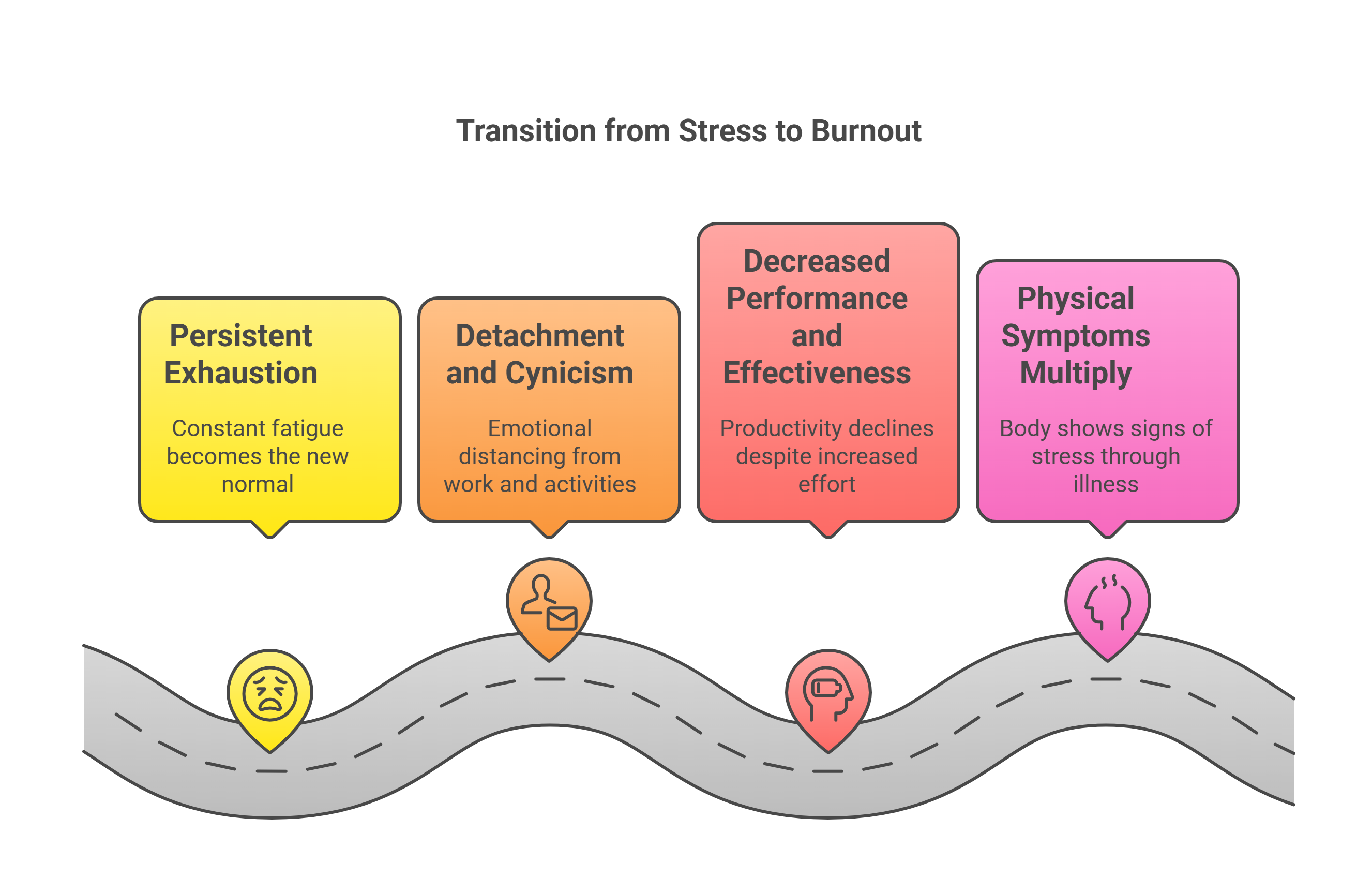
From Stress to Burnout: Why Your Body's Alarm System Is Stuck in the "On" Position
In today's always-on world, the line between healthy pressure and harmful stress has never been blurrier. Many of us are walking a dangerous tightrope without even realizing it – until we suddenly find ourselves in the grips of burnout. But what exactly happens in our minds and bodies as we travel this path from everyday stress to complete exhaustion? Let's explore the science behind this modern epidemic and discover ways to break the cycle before it breaks you.
The Stress-Burnout Pipeline: How One Feeds the Other
Stress isn't inherently bad. In fact, our stress response evolved as a sophisticated survival mechanism. When we perceive a threat, our bodies release hormones like cortisol and adrenaline that prepare us to fight or flee – increasing heart rate, sharpening focus, and diverting energy to our muscles.The problem occurs when this response never turns off.
Dr. Robert Sapolsky, professor of biology and neurology at Stanford University, explains it this way:
"If you're running for your life, you don't want to be bothered with digesting your breakfast. You don't want to be thinking about reproducing. You don't want tissue repair. You want to be running for your life. The stress response is fabulous for dealing with short-term physical emergencies. It is disastrous when activated chronically for psychological reasons."
This chronic activation creates a cascade of physiological and psychological changes that gradually lead to burnout – a state of complete mental, physical, and emotional exhaustion.

The Warning Signs Your Stress Is Becoming Burnout
The transition from stress to burnout isn't sudden – it happens gradually, with several recognizable stages:
1. Persistent Exhaustion
When you're experiencing healthy pressure, rest usually restores your energy. But as you move toward burnout, that restoration stops happening. You wake up tired even after a full night's sleep. This constant fatigue becomes your new normal.
2. Detachment and Cynicism
As burnout progresses, you may notice yourself becoming more cynical and detached from work, relationships, and activities you once enjoyed. This emotional distancing serves as a protection mechanism – if you don't care as much, it won't hurt as much.
3. Decreased Performance and Effectiveness
Despite working harder or longer hours, your productivity actually declines. Tasks that once came easily now require enormous effort, and your ability to concentrate diminishes significantly.
4. Physical Symptoms Multiply
Your body starts sending clear distress signals: headaches, stomach issues, changes in appetite or sleep patterns, and increased vulnerability to illness as your immune system weakens under constant stress.
The Science Behind Stress Overload
What's actually happening in your body during this progression is fascinating and alarming. According to Dr. Amelia Nagoski, co-author of "Burnout: The Secret to Unlocking the Stress Cycle," the problem isn't just the stressors themselves but our incomplete stress cycles.
"When you face a stressor, your body activates a stress response. When the stressor goes away, your body is supposed to return to baseline. But in modern life, the stressors rarely go away completely – and even when they do, we often don't take the time to allow our bodies to complete the stress cycle."
This incomplete cycle keeps stress hormones circulating in your system, creating a state of chronic arousal that damages virtually every system in your body over time.
Breaking the Cycle: How to Prevent Burnout Before It Happens
Preventing burnout requires addressing both the external stressors in your life and the internal ways you respond to them:
Create Clear Boundaries
In our hyper-connected world, work can easily bleed into personal time. Establish firm boundaries around when you're available and when you're not. Turn off notifications during personal time and communicate these limits clearly to colleagues.
Practice Stress Completion Rituals
Find activities that signal to your body that the danger has passed and it's safe to return to baseline. Physical exercise, deep breathing, social connection, creative expression, laughter, and tears can all help complete the stress cycle.
Prioritize Rest and Recovery
Rest isn't just a luxury – it's biologically necessary for preventing burnout. Build regular periods of true rest into your schedule, not just time when you're doing different work.
Reassess Your Values and Priorities
Often burnout occurs when we're pouring energy into areas that don't align with our core values. Regularly check in with yourself about whether your daily activities reflect what truly matters to you.

When to Seek Professional Help
If you're already experiencing significant burnout symptoms, don't hesitate to reach out for professional support. A healthcare provider or mental health professional can offer personalized strategies and, if necessary, medical interventions to help you recover.
The World Health Organization officially recognized burnout as an "occupational phenomenon" in the International Classification of Diseases (ICD-11), defining it as
"a syndrome conceptualized as resulting from chronic workplace stress that has not been successfully managed."
This recognition underscores an important truth: burnout isn't a personal failing or weakness – it's a predictable response to chronic stress without adequate support or recovery time.
The Bottom Line
The path from stress to burnout isn't inevitable. By understanding the warning signs, respecting your body's limits, and implementing strategic recovery practices, you can maintain healthy pressure without tipping into harmful territory. Remember that sustainable productivity requires cycles of engagement and recovery – not a constant sprint that ultimately leads nowhere except exhaustion.
Your body's stress response system is designed to protect you, not harm you. By working with this system rather than against it, you can harness its power while avoiding its pitfalls.
 Add Row
Add Row  Add
Add 




 Add Row
Add Row  Add
Add 

Write A Comment